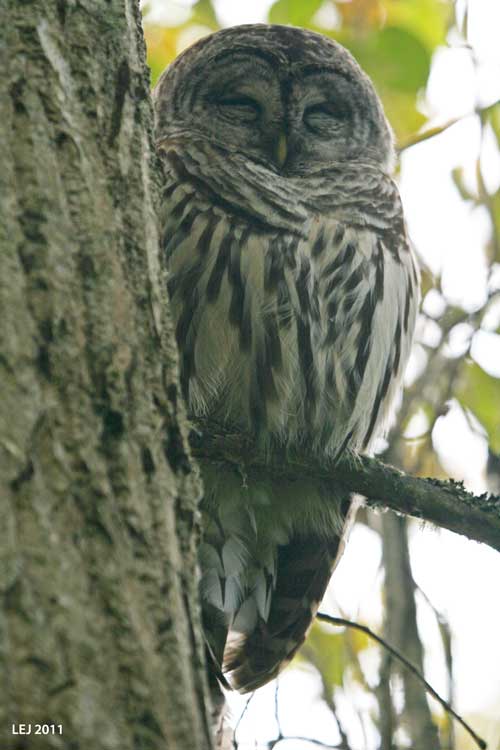Like fog clinging to moss, like smoke wafting over trees, the Barred Owl floats noiselessly to its favorite perch in the swamp: a cottonwood nook hidden from the prying eyes of its enemies, the crows and jays who are ever on the lookout for this silent predator.
Barred Owls have come to Yesler Swamp for the first time in history. If you search the branches near large tree trunks, you may find this new resident sleeping the day away. It will no doubt see you before you ever see it, blinking open its eyes to squint at you, checking to see whether you are harmless.
If you are quiet and respectful, the owl will slowly close its eyes again and go back to sleep. But in that moment when you lock eyes, you will discover why this owl has always been so mysterious to us. Its eyes are black, with no visible pupil or any white rim, like two lumps of living coal. In them you can see nothing — or everything. In them you can get lost.
FUN FACTS ABOUT BARRED OWLS
• Barred Owls are not native to Washington. They have been slowly expanding their territory on their own, moving in from the east.
• In old growth forests, they are replacing our native Spotted Owl, probably because Barred Owls are more aggressive than Spotties, more omnivorous, and more tolerant of habitat degradation. In other words, Barred Owls are less choosy, so their opportunities for expansion are much greater.
• Barred Owls eat almost anything they can catch, including small mammals, other birds, amphibians, and even large insects. They hunt by hiding quietly in cover, then they fly out suddenly on silent wings.
• The feathers of the owls’ wings are fringed with tiny tufts that break up
• Barred Owls are monogamous. The female lays and broods the eggs, while the male hunts for her. When the eggs hatch, the female continues to keep the babies warm while the male hunts even harder to feed the whole family. It takes more than eleven weeks from the time eggs are laid to the time the babies can leave the nest.
• Owls cannot turn their eyes to look in different directions. Instead, they turn their whole heads. Owls have twice as many vertebrae in their necks as humans do and can turn their heads in a range of 270 degrees.
• Barred Owls hunt mostly at night, which is why they need their big eyes: to see in the dark.
• One way to find owls is to look for “owl pellets” under their roosting trees. Owl pellets are compressed balls of the indigestible leftovers from their food: bones, claws, fur, and teeth. These pellets must be regurgitated before the owl can eat again.
• When a Barred Owl is about to regurgitate a pellet, it stretches out its neck, opens its bill, and hacks. The pellet then drops out.

